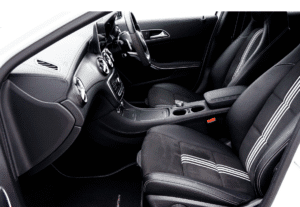Mon – Fri 8am – 10pm, Sat 9am – 5pm, Sun 9am – 10pm
Mon – Fri 8am – 10pm, Sat 9am – 5pm, Sun 9am – 10pm
Mon – Fri 8am – 10pm, Sat 9am – 5pm, Sun 9am – 10pm
Mon – Fri 8am – 10pm, Sat 9am – 5pm, Sun 9am – 10pm
Key Takeaways:
Car alarms still deter opportunistic thieves.
Professional thieves easily bypass traditional alarms.
Layered security offers the best protection.
Upgrading to smart alarm systems makes a difference.

While car alarms remain a popular feature in vehicles across the UK with their piercing sirens designed to deter thieves and alert owners, there are issues in 2025 that car owners need to appreciate.
That’s because car theft methods are becoming ever more sophisticated which raises the question of whether traditional car alarms are still effective and or do you need additional layers of security to keep your vehicle safe?
Here, the car security experts, Ghost Installations, look at modern car alarms to explore their strengths, limitations, and what else you might need to protect your car from modern thieves.
Car alarms became widespread in the 1980s, designed to deter theft by emitting a loud siren when a vehicle is tampered with, such as smashed windows or forced locks.
Most cars in 2025 still come with factory-fitted alarms as standard, often integrated with the vehicle’s electronics.
These systems are triggered by actions like opening a door without the key or attempting to start the engine improperly.
A blinking LED on the dashboard often signals an active alarm, acting as a visible deterrent.
But in an era of keyless entry theft and electronic hacking, does a loud noise still scare off thieves, or have they adapted to bypass these systems entirely?
There’s no denying that car alarms can still deter opportunistic thieves.
A sudden blaring siren might spook an amateur crook trying to smash a window or prise open a door, especially in a busy area where attention could be drawn.
If you’re nearby, the alarm can alert you to tampering, allowing you to intervene.
The visible presence of an alarm, such as the blinking LED mentioned above, can also discourage joyriders or petty thieves looking for an easy target.
In short, alarms still have a role as part of a vehicle’s ‘visible’ security, potentially stopping low-level theft attempts before they escalate.
However, car alarms face a significant challenge: alarm fatigue.
You might not have heard of the term but in urban areas, the sound of sirens is so common they’ve become background noise – one survey revealed that just 1% of people would call the police when hearing a car alarm.
Apparently, most people assume it’s a false alarm triggered by wind or passing lorries.
Seasoned thieves exploit this fatigue, knowing they can operate quickly and disappear before anyone reacts.
Modern thieves have developed ways to neutralise car alarms with alarming efficiency.
Experienced criminals can often silence an alarm in under a minute, with some surveys suggesting up to 80% of professional thieves can disable a siren by accessing the vehicle’s on-board diagnostics (OBD) port or cutting wires under the bonnet.
More worryingly, advanced theft methods like relay attacks, where thieves use electronic devices to capture and mimic a key fob’s signal, can bypass alarms entirely.
In these cases, the car’s system is tricked into thinking the legitimate key is present, so it unlocks and disarms the alarm without a sound.
For many modern thefts, the alarm doesn’t even get a chance to activate.
Consider a common scenario in 2025: you wake up to find your keyless-entry car gone, with no sign of forced entry or an alarm having sounded.
This is often the result of a relay attack, where thieves use a device to extend the signal from your key fob, which is usually inside your home, to unlock and start the car.
Alternatively, some thieves program a blank key via the OBD port, again fooling the car into thinking it’s an authorised start.
In both cases, the factory alarm is rendered useless because the vehicle’s systems register the entry as legitimate.
These ‘silent’ thefts highlight a critical blind spot in traditional car alarm systems.
Car alarms remain a valuable layer of security, particularly against opportunistic crimes like smash-and-grab thefts targeting valuables or car stereos.
The noise and attention they generate can deter less experienced thieves, and many UK insurance policies require at least a Thatcham Category 1 alarm/immobiliser system as a minimum.
Having an alarm is undoubtedly better than having none.
However, their limitations, the public’s car alarm fatigue, easy disabling by pros and vulnerability to electronic bypass methods, mean they cannot be relied upon as the sole defence against theft in 2025.
To truly secure your vehicle, additional measures are essential.
Immobilisers and trackers form the backbone of a robust security strategy.
A kill-switch immobiliser, whether it’s factory-fitted or aftermarket, like the Ghost Immobiliser, prevents the car from starting, even if a thief bypasses the alarm or gains entry.
Trackers, on the other hand, offer a second chance by allowing you to locate your vehicle if it’s stolen.
Together, these create a powerful security combination: an alarm might scare a thief off, an immobiliser stops them from driving away, and a tracker helps recover the car if all else fails.
According to the Police Crime Prevention Blog, combining these technologies significantly reduces the risk of theft and increases recovery chances.
If your car’s factory alarm feels outdated, consider upgrading to a modern aftermarket system.
Advanced alarms now offer features like smartphone notifications, tilt or shock sensors, and even GPS tracking.
Tilt sensors, for example, can detect wheel theft or towing, scenarios that basic factory alarms often miss.
Smartphone app alerts ensure you’re informed of a breach, reducing reliance on indifferent neighbours.
Upgrading to a system like the Toad Car Alarm can make your alarm more relevant by addressing modern theft tactics, offering both deterrence and real-time alerts.
So, do car alarms still work in 2025?
Yes, but only as part of a broader security strategy.
They remain a useful deterrent against amateur thieves and tampering, but their effectiveness is limited by public desensitisation to its noise and sophisticated theft methods like relay attacks.
To keep your car safe, combine an alarm with an immobiliser to prevent unauthorised starts and consider a tracker for recovery if the worst happens.
For older vehicles with basic alarms, upgrading to a modern system with smartphone alerts or tilt sensors can bridge the gap.
If your car lacks any security, a Thatcham Category 1 alarm/immobiliser is a must.
At Ghost Installations, you can explore options like the Ghost Immobiliser or advanced alarms to complement your vehicle’s defences.

Gareth Brooks is a vehicle security expert and Managing Director of Ghost Installations, specialising in advanced tracking systems and theft prevention solutions across the UK.
Some of our Frequently Asked Questions
Our head office is based in Halifax, however our engineers are based nationwide to cover all the UK.
It’s dependent on the vehicle, usually around 2 hours.
We have a dedicated aftercare team who can assist you, after verification we are able to support you to change the code.
It can be changed by you at any point and you can do this at any time and each day if you wish for maximum security
The device detects if your car has start / stop technology so you enter the code when you initially start the car and get into it and that’s it. If the car stops at traffic lights it automatically restarts as it normally would do before you had the ghost fitted.
Speak to one of our dedicated account managers to find the correct deal to support your install. We always have offers available.
When the car is being driven by others, you can enter service mode so your code is not compromised to the garage. The car stays in service mode until driven over 30 mph or if you take it out of service mode. (Please ask on the day of installation how this is done.)
The product is guaranteed for two years.
You can have it removed by us or leave it in the car as a sales feature to get more for your car with it fitted. Please note there will be an additional charge for this service.
We can remove and refit if required once your lease has ended. Please note there will be an additional charge for this service.